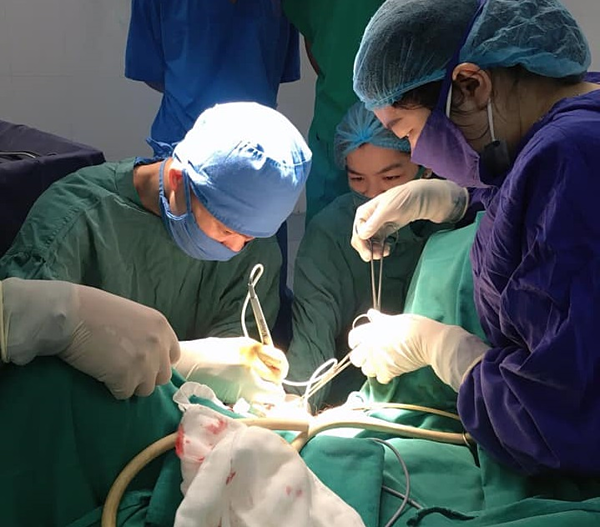Vaginal hysterectomy for genital prolapse
Vaginal hysterectomy is highly effective in treating genital prolapse. The surgery has outstanding advantages such as not making an incision on the abdomen, ensuring high aesthetics, fast recovery time, and reduced treatment costs.
1. Indications for transvaginal hysterectomy
Vaginal hysterectomy for genital prolapse is also known as Crossen surgery. Surgical treatment of genital prolapse by performing a vaginal hysterectomy, suturing the bladder, suturing the ligaments on both sides together to form a solid network along with suturing the vaginal apex. to prevent the intestines from prolapse. This is a difficult technique, requires highly qualified doctors, and is only performed at provincial and central hospitals.
Hysterectomy is indicated in women with grade III genital prolapse and no need to continue having children. Grade III genital prolapse is a case where the cervix drops down, completely prolapses outside the vulva. In addition, the surgery is only performed when the woman is healthy enough (do not operate for people who are too old and weak or have cardiovascular diseases, blood diseases, diabetes, etc.); The condition of the uterus and vagina is stable, without any inflammation. If there is an infection, it should be treated before surgery.
2. Steps to perform surgery
Tense 1: Expose the cervix Tense 2: Open the same posterior and probe Tense 3: Open the same anterior, dissection push the bladder upwards Tense 4: Ligation and cut the ligaments and uterine pedicles Tense 5 : Ligation and resection of the uterine pedicle and broad ligament Push the cut ligament upward, exposing the tissue above the ligament Tense 6: Cut two appendages Tense 7: Check for bleeding Tense 8: Close the sacral peritoneal Patients after hysterectomy need to be closely monitored, especially in the first 24 hours and the first days after surgery to assess the possibility of recovery, bleeding status and care. Post-surgery genital care.

Phẫu thuật cắt tử cung qua đường âm đạo
Important issues to monitor in the patient include:
Monitor vital signs, especially during the first 24 hours after surgery Monitor vaginal and intra-abdominal bleeding Monitor and care for urinary catheters Clean genitals: Wipe the vagina and perineum with betadine solution or other antiseptic solutions Reasonable diet: Give the patient a liquid diet and exercise soon after surgery Complications are unavoidable in all surgical interventions. Some of the common complications after a vaginal hysterectomy include:
Bleeding due to thread loss or blood vessel tightening Injury to the bladder and rectum during dissection Infection due to ulcers Vaginal and cervical ulcers have not been cured To help customers detect and treat other gynecological diseases early, Vinmec International General Hospital has a package of basic gynecological examination and screening, helping customers Early detection of inflammatory diseases makes treatment easy and inexpensive. Screening detects gynecological cancer (cervical cancer) early even when there are no symptoms.
Để đặt lịch khám tại viện, Quý khách vui lòng bấm số HOTLINE hoặc đặt lịch trực tiếp TẠI ĐÂY. Tải và đặt lịch khám tự động trên ứng dụng MyVinmec để quản lý, theo dõi lịch và đặt hẹn mọi lúc mọi nơi ngay trên ứng dụng.
Bài viết này được viết cho người đọc tại Sài Gòn, Hà Nội, Hồ Chí Minh, Phú Quốc, Nha Trang, Hạ Long, Hải Phòng, Đà Nẵng.






